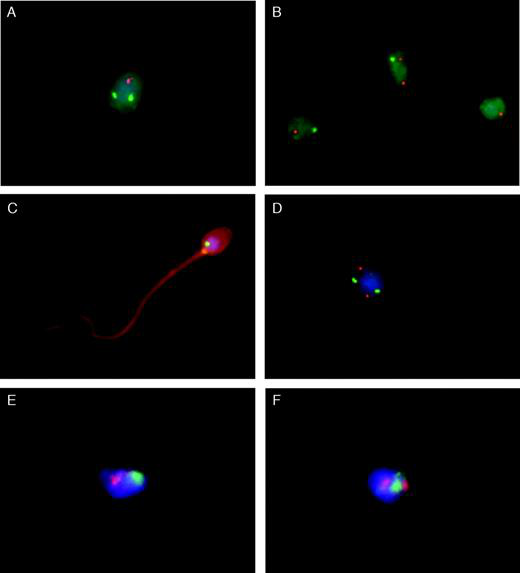Cytogenetic Analysis of Human Germ Cell Mitosis
FISH on Human Meiotic Samples
Chromosomal in situ hybridization can unambiguously identify target human somatic chromosomes, and methods to visualize multiple target chromosomes simultaneously by FISH have been developed and widely used in the analysis of somatic and meiotic processes. FISH allows the rapid identification of chromosomes throughout meiosis, allowing the characterization of meiotic abnormalities in human males and females. For example, information on the frequency of meiotic aneuploidy in humans is largely due to the use of FISH on sperm and oocytes or polar bodies. The processing of different meiotic samples and FISH procedures vary slightly, most of which stem from the complexity of the samples themselves. The application of FISH protocols to meiotic cells requires the adaptation of standard protocols to the specificity of these cells. Specific sample fixation is often required, and in some cases, samples require specific preprocessing to guarantee successful FISH. Currently, whole chromosome mapping (WCP), centromere (CEN), site-specific probes, and M-FISH techniques have been used to identify specific bivalents at different stages of meiosis. Including the study of various aspects of the meiotic process chromosome behavior during meiosis in control and infertile males and females. Our FISH technology platform provides a comprehensive solution for the analysis of human meiotic samples.
 Fig 1. Dual FISH on decondensed sperm nuclei using either locus-specific probes (LSPs) or whole chromosome painting (WCP) probes. (Moradkhani K, et al. 2006)
Fig 1. Dual FISH on decondensed sperm nuclei using either locus-specific probes (LSPs) or whole chromosome painting (WCP) probes. (Moradkhani K, et al. 2006)
FISH for Human Meiotic Samples
The use of FISH in meiotic cytogenetic studies is very useful, providing researchers with important information about the many processes that occur during human gametogenesis. This information has important implications for the study of infertility-related diseases.
- Sperm FISH. The most frequently included chromosomes in sperm FISH analysis are chromosomes X, Y, 13, 18, and 21, which can be appropriately increased or decreased according to the researcher's analysis needs. Our sperm FISH analysis protocol includes 2 key sample preparation steps, which are how to process and fix human semen samples and how to decondensation and denature sperm chromatin. These steps will determine the quality of the FISH analysis.
- MII and PB FISH. The application of FISH on the polar body (PB) and meiosis 2 (MII) oocytes has been shown to be useful in the analysis of maternally derived transmitted chromosomal alterations. Similar to the sperm FISH procedure, the key to this solution is good chromosome preparation and accurate chromosome identification. Our platform provides in-house optimized solutions to provide you with comprehensive analytics.
- FISH on male /female meiotic chromosomes. This service can be a combined service, which can be carried out separately for samples from men or women. With partial chromosome painting probes, this service of ours has an advantage for customers who have a well-defined target for chromosome resolution.
- FISH on male/female SC. The evolutionary conservation of SC makes it an excellent tool for studying prophase chromosome organization as well as specific aspects of meiosis. We offer solutions for SC analysis in mitotic samples.
 Fig 2. Methods for FISH analysis in human germ cells.
Fig 2. Methods for FISH analysis in human germ cells.
Applications
FISH is also a very useful chromosomal diagnostic technique for characterizing chromosomal abnormalities during meiosis.
Investigate synaptic initiation and homology searches and the behavior of specific chromosomes during meiotic prophase I.
Translocations exhibit a specific pattern of segregation during meiosis, resulting in a higher proportion of unbalanced gametes.
Diagnosis of the most common chromosomal abnormality in humans - aneuploidy.
Creative Bioarray provides a comprehensive FISH solution for the resolution of chromosomal abnormalities. You will find solutions to your research needs through our technology platform. If you are interested in our service, please contact us for cooperation. We look forward to cooperating with you in the near future.
Reference
- Moradkhani K, Puechberty J, Bhatt S, et al. Rare Robertsonian translocations and meiotic behaviour: sperm FISH analysis of t (13; 15) and t (14; 15) translocations: a case report[J]. Human Reproduction, 2006, 21(12): 3193-3198.
All products and services on this website are only suitable for non-medical purposes.


 Fig 1. Dual FISH on decondensed sperm nuclei using either locus-specific probes (LSPs) or whole chromosome painting (WCP) probes. (Moradkhani K, et al. 2006)
Fig 1. Dual FISH on decondensed sperm nuclei using either locus-specific probes (LSPs) or whole chromosome painting (WCP) probes. (Moradkhani K, et al. 2006) Fig 2. Methods for FISH analysis in human germ cells.
Fig 2. Methods for FISH analysis in human germ cells.


